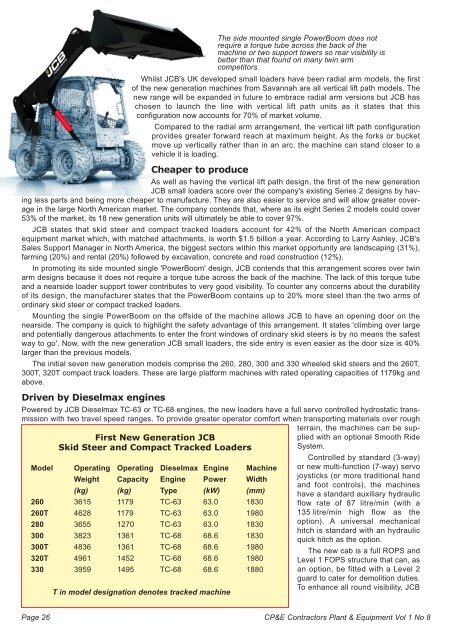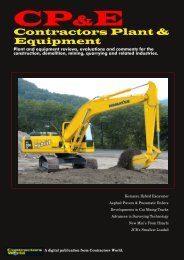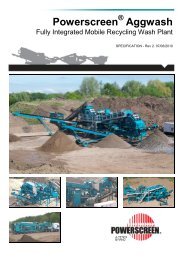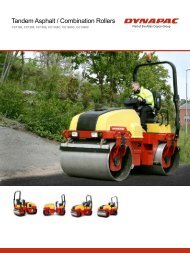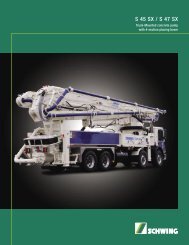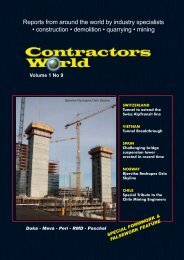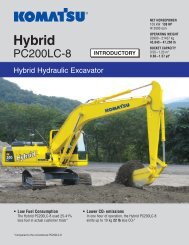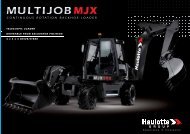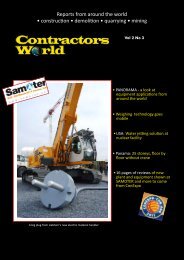download pdf version - Contractors World
download pdf version - Contractors World
download pdf version - Contractors World
Create successful ePaper yourself
Turn your PDF publications into a flip-book with our unique Google optimized e-Paper software.
Whilst JCB's UK developed small loaders have been radial arm models, the first<br />
of the new generation machines from Savannah are all vertical lift path models. The<br />
new range will be expanded in future to embrace radial arm <strong>version</strong>s but JCB has<br />
chosen to launch the line with vertical lift path units as it states that this<br />
configuration now accounts for 70% of market volume.<br />
Compared to the radial arm arrangement, the vertical lift path configuration<br />
provides greater forward reach at maximum height. As the forks or bucket<br />
move up vertically rather than in an arc, the machine can stand closer to a<br />
vehicle it is loading.<br />
Cheaper to produce<br />
As well as having the vertical lift path design, the first of the new generation<br />
JCB small loaders score over the company's existing Series 2 designs by having<br />
less parts and being more cheaper to manufacture. They are also easier to service and will allow greater coverage<br />
in the large North American market. The company contends that, where as its eight Series 2 models could cover<br />
53% of the market, its 18 new generation units will ultimately be able to cover 97%.<br />
JCB states that skid steer and compact tracked loaders account for 42% of the North American compact<br />
equipment market which, with matched attachments, is worth $1.5 billion a year. According to Larry Ashley, JCB's<br />
Sales Support Manager in North America, the biggest sectors within this market opportunity are landscaping (31%),<br />
farming (20%) and rental (20%) followed by excavation, concrete and road construction (12%).<br />
In promoting its side mounted single 'PowerBoom' design, JCB contends that this arrangement scores over twin<br />
arm designs because it does not require a torque tube across the back of the machine. The lack of this torque tube<br />
and a nearside loader support tower contributes to very good visibility. To counter any concerns about the durability<br />
of its design, the manufacturer states that the PowerBoom contains up to 20% more steel than the two arms of<br />
ordinary skid steer or compact tracked loaders.<br />
Mounting the single PowerBoom on the offside of the machine allows JCB to have an opening door on the<br />
nearside. The company is quick to highlight the safety advantage of this arrangement. It states 'climbing over large<br />
and potentially dangerous attachments to enter the front windows of ordinary skid steers is by no means the safest<br />
way to go'. Now, with the new generation JCB small loaders, the side entry is even easier as the door size is 40%<br />
larger than the previous models.<br />
The initial seven new generation models comprise the 260, 280, 300 and 330 wheeled skid steers and the 260T,<br />
300T, 320T compact track loaders. These are large platform machines with rated operating capacities of 1179kg and<br />
above.<br />
Driven by Dieselmax engines<br />
Powered by JCB Dieselmax TC-63 or TC-68 engines, the new loaders have a full servo controlled hydrostatic transmission<br />
with two travel speed ranges. To provide greater operator comfort when transporting materials over rough<br />
First New Generation JCB<br />
Skid Steer and Compact Tracked Loaders<br />
Model Operating Operating Dieselmax Engine Machine<br />
Weight Capacity Engine Power Width<br />
(kg) (kg) Type (kW) (mm)<br />
260 3615 1179 TC-63 63.0 1830<br />
260T 4628 1179 TC-63 63.0 1980<br />
280 3655 1270 TC-63 63.0 1830<br />
300 3823 1361 TC-68 68.6 1830<br />
300T 4836 1361 TC-68 68.6 1980<br />
320T 4961 1452 TC-68 68.6 1980<br />
330 3959 1495 TC-68 68.6 1880<br />
T in model designation denotes tracked machine<br />
The side mounted single PowerBoom does not<br />
require a torque tube across the back of the<br />
machine or two support towers so rear visibility is<br />
better than that found on many twin arm<br />
competitors.<br />
terrain, the machines can be supplied<br />
with an optional Smooth Ride<br />
System.<br />
Controlled by standard (3-way)<br />
or new multi-function (7-way) servo<br />
joysticks (or more traditional hand<br />
and foot controls), the machines<br />
have a standard auxiliary hydraulic<br />
flow rate of 87 litre/min (with a<br />
135 litre/min high flow as the<br />
option). A universal mechanical<br />
hitch is standard with an hydraulic<br />
quick hitch as the option.<br />
The new cab is a full ROPS and<br />
Level 1 FOPS structure that can, as<br />
an option, be fitted with a Level 2<br />
guard to cater for demolition duties.<br />
To enhance all round visibility, JCB<br />
Page 26 CP&E <strong>Contractors</strong> Plant & Equipment Vol 1 No 8


